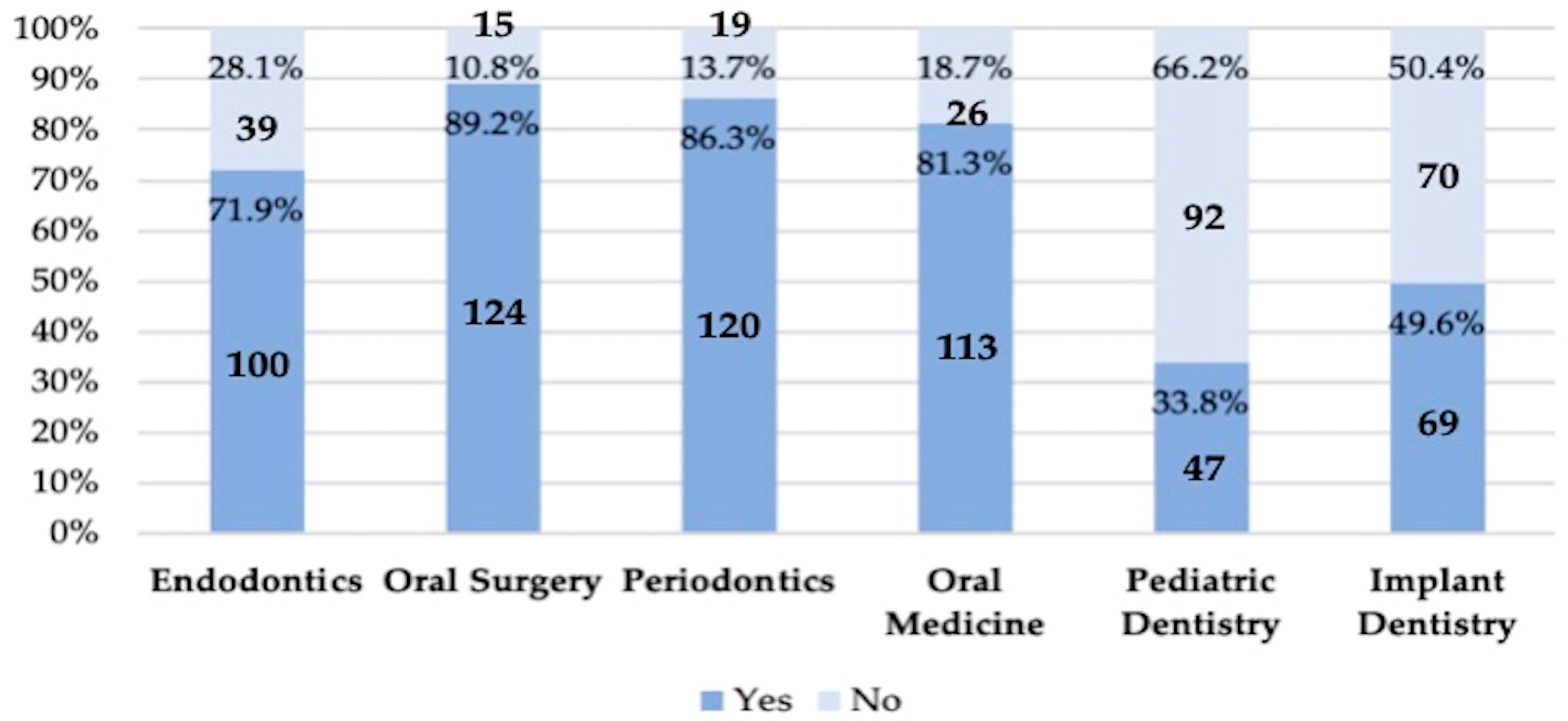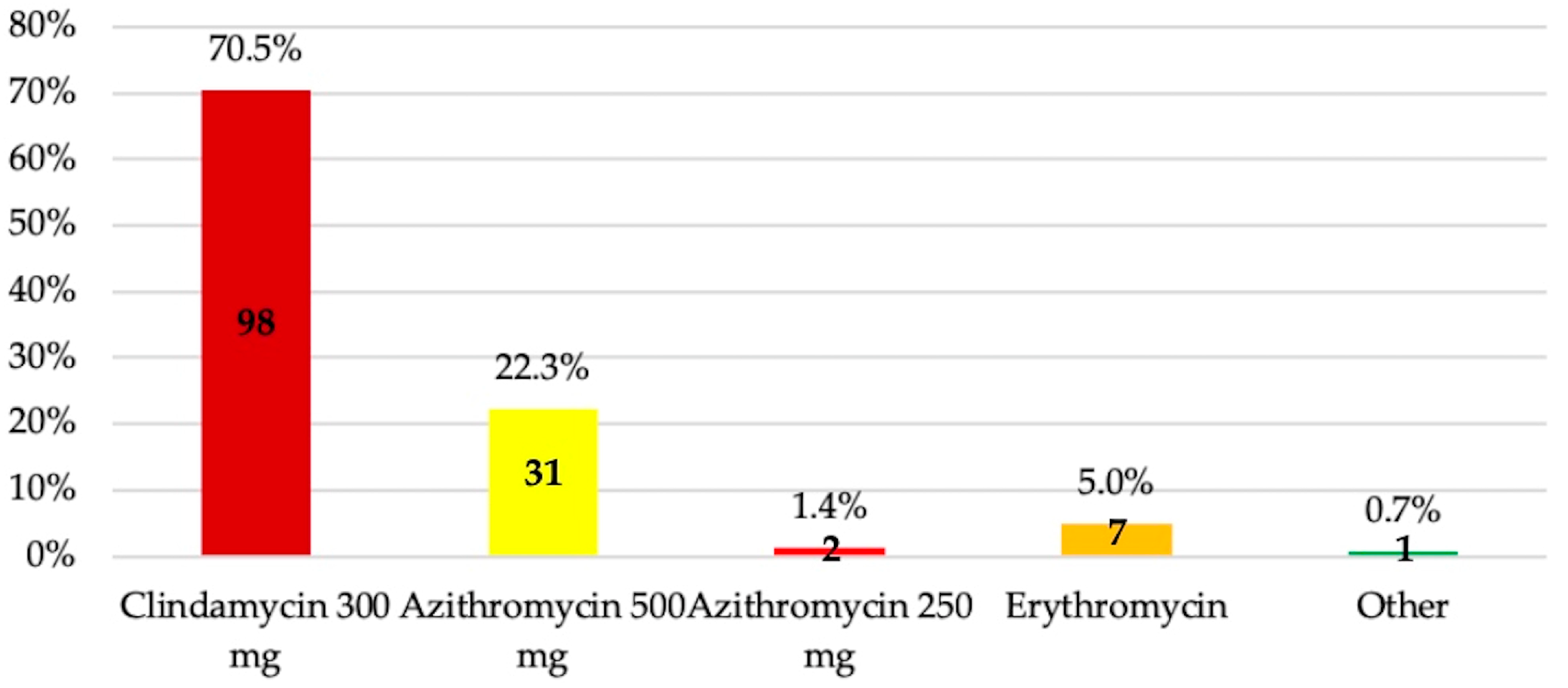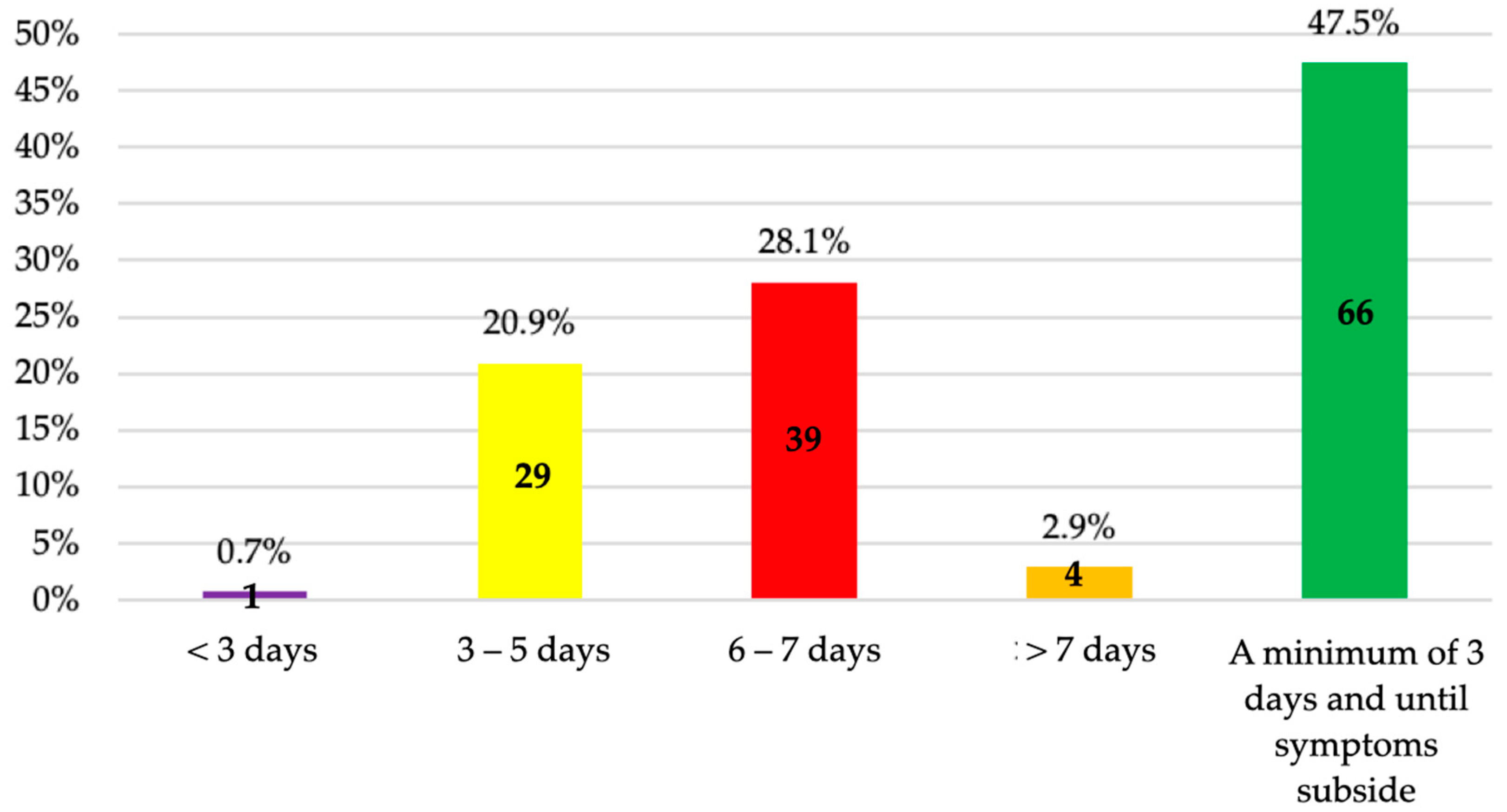Self-Perception and Assessment of Antibiotic Therapy Knowledge in Dental Students in Spain: A Cross-Sectional Observational Study
Abstract
1. Introduction
2. Materials and Methods
2.1. Study Design
2.2. Hypothesis
2.3. Questionnaire
2.4. Sample Size Calculation
2.5. Statistical Analysis
3. Results
3.1. Descriptive Data
3.2. Main Results Regarding Their Training in Antibiotic Therapy
3.3. Knowledge About Antibiotic Therapy in Endodontics
4. Discussion
4.1. Limitations
4.2. Recommendations for Further Research
5. Conclusions
Supplementary Materials
Author Contributions
Funding
Institutional Review Board Statement
Informed Consent Statement
Data Availability Statement
Conflicts of Interest
References
- Salgado-Peralvo, A.O.; Kewalramani, N.; Garcia-Sanchez, A.; Peña-Cardelles, J.F. “Antibiotic Prophylaxis” and “Preventive Antibiotic Therapy”: Two Sides of the Same Coin. J. Stomatol. Oral Maxillofac. Surg. 2022, 123, e159–e160. [Google Scholar] [CrossRef]
- Oberoi, S.S.; Dhingra, C.; Sharma, G.; Sardana, D. Antibiotics in Dental Practice: How Justified Are We. Int. Dent. J. 2015, 65, 4–10. [Google Scholar] [CrossRef]
- Salgado-Peralvo, A.O.; Kewalramani, N.; Mateos-Moreno, M.V. Antibiotic Resistance: The Silent Pandemia (in the COVID-19 Era). Int. Dent. J. 2023, 73, 328–329. [Google Scholar] [CrossRef]
- Bhattacharya, S. The Facts about Penicillin Allergy: A Review. J. Adv. Pharm. Technol. Res. 2010, 1, 11–17. [Google Scholar] [CrossRef]
- Review on Antimicrobial Resistance. Antimicrobial Resistance: Tackling a Crisis for the Health and Wealth of Nations. 2014. Available online: https://amr-review.org/sites/default/files/AMR%20Review%20Paper%20-%20Tackling%20a%20crisis%20for%20the%20health%20and%20wealth%20of%20nations_1.pdf (accessed on 1 June 2025).
- World Health Organization. Record Number of Countries Contribute Data Revealing Disturbing Rates of Antimicrobial Resistance; World Health Organization: Geneva, Switzerland, 2020; Available online: https://www.who.int/news/item/01-06-2020-record-number-of-countries-contribute-data-revealing-disturbing-rates-of-antimicrobial-resistance (accessed on 1 June 2025).
- World Health Organization; Food and Agriculture Organization of the United Nations; World Organisation for Animal Health. Contributing to One World, One Health. A Strategic Framework for Reducing Risks of Infectious Diseases at the Animal-Human-Ecosystems Interface; World Health Organization: Geneva, Switzerland; Food and Agriculture Organization of the United Nations: Rome, Italy; World Organisation for Animal Health: Paris, France, 2008; Available online: https://www.fao.org/4/aj137e/aj137e00.pdf (accessed on 1 June 2025).
- Agencia Española de Medicamentos y Productos Sanitarios. Plan Nacional Frente a La Resistencia a Los Antibióticos 2014–2018; Agencia Española de Medicamentos y Productos Sanitarios: Madrid, Spain, 2014.
- Dar-Odeh, N.S.; Abu-Hammad, O.A.; Al-Omiri, M.K.; Khraisat, A.S.; Shehabi, A.A. Antibiotic Prescribing Practices by Dentists: A Review. Ther. Clin. Risk Manag. 2010, 6, 301–306. [Google Scholar] [CrossRef]
- Roberts, R.M.; Bartoces, M.; Thompson, S.E.; Hicks, L.A. Antibiotic Prescribing by General Dentists in the United States, 2013. J. Am. Dent. Assoc. 2017, 148, 172–178.e1. [Google Scholar] [CrossRef]
- AboAlSamh, A.; Alhussain, A.; Alanazi, N.; Alahmari, R.; Shaheen, N.; Adlan, A. Dental Students’ Knowledge and Attitudes towards Antibiotic Prescribing Guidelines in Riyadh, Saudi Arabia. Pharmacy 2018, 6, 42. [Google Scholar] [CrossRef]
- Sukumar, S.; Martin, F.; Hughes, T.; Adler, C. Think before You Prescribe: How Dentistry Contributes to Antibiotic Resistance. Aust. Dent. J. 2020, 65, 21–29. [Google Scholar] [CrossRef]
- Iqbal, A. The Attitudes of Dentists towards the Prescription of Antibiotics during Endodontic Treatment in North of Saudi Arabia. J. Clin. Diagn. Res. 2015, 9, ZC82–ZC84. [Google Scholar] [CrossRef]
- Agencia Nacional de Evaluación de la Calidad y Acreditación. Libro Blanco Del Título de Grado En Odontología; Agencia Nacional de Evaluación de la Calidad y Acreditación: Madrid, Spain, 2004. Available online: https://www.aneca.es/documents/20123/63950/libroblanco_odontologia_def.pdf/4c83caf6-70f2-3c61-69df-281480d59dcc?t=1654601748929 (accessed on 1 June 2025).
- Von Elm, E.; Altman, D.G.; Egger, M.; Pocock, S.J.; Gøtzsche, P.C.; Vandenbroucke, J.P. The Strengthening the Reporting of Observational Studies in Epidemiology (STROBE) Statement: Guidelines for Reporting Observational Studies. J. Clin. Epidemiol. 2008, 61, 344–349. [Google Scholar] [CrossRef]
- Martín-Jiménez, M.; Martín-Biedma, B.; López-López, J.; Alonso-Ezpeleta, O.; Velasco-Ortega, E.; Jiménez-Sánchez, M.C.; Segura-Egea, J.J. Dental Students’ Knowledge Regarding the Indications for Antibiotics in the Management of Endodontic Infections. Int. Endod. J. 2018, 51, 118–127. [Google Scholar] [CrossRef]
- Segura-Egea, J.J.; Velasco-Ortega, E.; Torres-Lagares, D.; Velasco-Ponferrada, M.C.; Monsalve-Guil, L.; Llamas-Carreras, J.M. Pattern of Antibiotic Prescription in the Management of Endodontic Infections amongst Spanish Oral Surgeons. Int. Endod. J. 2010, 43, 342–350. [Google Scholar] [CrossRef]
- Rodriguez-Núñez, A.; Cisneros-Cabello, R.; Velasco-Ortega, E.; Llamas-Carreras, J.M.; Tórres-Lagares, D.; Segura-Egea, J.J. Antibiotic Use by Members of the Spanish Endodontic Society. J. Endod. 2009, 35, 1198–1203. [Google Scholar] [CrossRef]
- Yingling, N.M.; Byrne, B.E.; Hartwell, G.R. Antibiotic Use by Members of the American Association of Endodontists in the Year 2000: Report of a National Survey. J. Endod. 2002, 28, 396–404. [Google Scholar] [CrossRef]
- Holz, M.; Naavaal, S.; Stilianoudakis, S.; Carrico, C.; Byrne, B.E.; Myers, G.L. Antibiotics and Antimicrobial Resistance: Evaluation of the Knowledge, Attitude, and Perception among Students and Faculty within US Dental Schools. J. Dent. Educ. 2021, 85, 383–391. [Google Scholar] [CrossRef]
- Segura-Egea, J.J.; Gould, K.; Şen, B.H.; Jonasson, P.; Cotti, E.; Mazzoni, A.; Sunay, H.; Tjäderhane, L.; Dummer, P.M.H. European Society of Endodontology Position Statement: The Use of Antibiotics in Endodontics. Int. Endod. J. 2018, 51, 20–25. [Google Scholar] [CrossRef]
- Ministerio de Ciencia Innovación y Universidades. Estadística de Estudiantes. Estadísticas Universitarias; Ministerio de Ciencia Innovación y Universidades: Madrid, Spain, 2020. Available online: https://www.ciencia.gob.es/InfoGeneralPortal/documento/08f45793-116d-4df2-8ddd-207662c3c6ee (accessed on 20 June 2025).
- Requejo-Bustamante, A.P.; Perona-Miguel de Priego, G.A. Level of Knowledge in Undergraduate Dental Students about the Prescription of Analgesics, Anti-Inflammatories, and Antibiotics in Pediatric Dentistry. Rev. Cient. Odontol. 2023, 11, e173. [Google Scholar] [CrossRef]
- Guzmán-Álvarez, R.; Medeiros, M.; Lagunes, L.R.; Campos-Sepúlveda, A. Knowledge of Drug Prescription in Dentistry Students. Drug Healthc. Patient Saf. 2012, 4, 55–59. [Google Scholar] [CrossRef]
- Badran, A.S.; Keraa, K.; Farghaly, M.M. Applying the Kirkpatrick Model to Evaluate Dental Students’ Experience of Learning about Antibiotics Use and Resistance. Eur. J. Dent. Educ. 2022, 26, 756–766. [Google Scholar] [CrossRef]
- Schwartzberg, L.S. Neutropenia: Etiology and Pathogenesis. Clin. Cornerstone 2006, 8, S5–S11. [Google Scholar] [CrossRef]
- Mohammadi, Z. Systemic, Prophylactic and Local Applications of Antimicrobials in Endodontics: An Update Review. Int. Dent. J. 2009, 59, 175–186. [Google Scholar]
- Segura-Egea, J.J.; Gould, K.; Şen, B.H.; Jonasson, P.; Cotti, E.; Mazzoni, A.; Sunay, H.; Tjäderhane, L.; Dummer, P.M.H. Antibiotics in Endodontics: A Review. Int. Endod. J. 2017, 50, 1169–1184. [Google Scholar] [CrossRef]
- Fouad, A.F.; Abbott, P.V.; Tsilingaridis, G.; Cohenca, N.; Lauridsen, E.; Bourguignon, C.; O’Connell, A.; Flores, M.T.; Day, P.F.; Hicks, L.; et al. International Association of Dental Traumatology Guidelines for the Management of Traumatic Dental Injuries: 2. Avulsion of Permanent Teeth. Dent. Traumatol. 2020, 36, 331–342. [Google Scholar] [CrossRef]
- Sae-Lim, V.; Wang, C.Y.; Choi, G.W.; Trope, M. The Effect of Systemic Tetracycline on Resorption of Dried Replanted Dogs’ Teeth. Dent. Traumatol. 1998, 14, 127–132. [Google Scholar] [CrossRef]
- Hammarström, L.; Blomlöf, L.; Feiglin, B.; Andersson, L.; Lindskog, S. Replantation of Teeth and Antibiotic Treatment. Dent. Traumatol. 1986, 2, 51–57. [Google Scholar] [CrossRef]
- Agnihotry, A.; Thompson, W.; Fedorowicz, Z.; van Zuuren, E.J.; Sprakel, J. Antibiotic Use for Irreversible Pulpitis. Cochrane Database Syst. Rev. 2019, 5, CD004969. [Google Scholar] [CrossRef]
- Khalaf, L.H.; Kabbaj, S.; Toure, B. Attitudes of Dental Students towards the Prescription of Antibiotics during Endodontic Treatment. Antibiotics 2024, 13, 913. [Google Scholar] [CrossRef]
- Arıcan, B.; Çiftçioğlu, E.; Işık, V.; Karagöz-Küçükay, I. Evaluation of the Knowledge of Final-year Dental Students on the Use of Antibiotics in Endodontics in Turkey. Aust. Endod. J. 2021, 47, 320–326. [Google Scholar] [CrossRef]
- Yashin, A.N.; Thakuria, N.; Narzary, H.; Satnami, D.; Paul, N. A Questionnaire Based Survey on the Knowledge, Attitude and Practices about Antimicrobial Resistance and Usage among the MBBS Students and Doctors of a Tertiary Care Teaching Hospital in Silchar, Assam, India. Int. J. Basic Clin. Pharmacol. 2018, 7, 1630. [Google Scholar] [CrossRef]
- Yusef, D.; Babaa, A.I.; Bashaireh, A.Z.; Al-Bawayeh, H.H.; Al-Rijjal, K.; Nedal, M.; Kailani, S. Knowledge, Practices & Attitude toward Antibiotics Use and Bacterial Resistance in Jordan: A Cross-Sectional Study. Infect. Dis. Health 2018, 23, 33–40. [Google Scholar] [CrossRef]
- Jose, J.; Teja, K.V.; Palanivelu, A.; Khandelwal, A.; Siddique, R. Analgesic Efficacy of Corticosteroids and Nonsteroidal Anti-Inflammatory Drugs through Oral Route in the Reduction of Postendodontic Pain: A Systematic Review. J. Conserv. Dent. 2022, 25, 9–19. [Google Scholar] [CrossRef]
- Kassolis, J.D.; Scheper, M.; Jham, B.; Reynolds, M.A. Histopathologic Findings in Bone from Edentulous Alveolar Ridges: A Role in Osteonecrosis of the Jaws? Bone 2010, 47, 127–130. [Google Scholar] [CrossRef]
- Bolfoni, M.R.; Pappen, F.G.; Pereira-Cenci, T.; Jacinto, R.C. Antibiotic Prescription for Endodontic Infections: A Survey of Brazilian Endodontists. Int. Endod. J. 2018, 51, 148–156. [Google Scholar] [CrossRef]
- Trubiano, J.A.; Adkinson, N.F.; Phillips, E.J. Penicillin Allergy Is Not Necessarily Forever. JAMA 2017, 318, 82–83. [Google Scholar] [CrossRef]
- Trubiano, J.A.; Thursky, K.A.; Stewardson, A.J.; Urbancic, K.; Worth, L.J.; Jackson, C.; Stevenson, W.; Sutherland, M.; Slavin, M.A.; Grayson, M.L.; et al. Impact of an Integrated Antibiotic Allergy Testing Program on Antimicrobial Stewardship: A Multicenter Evaluation. Clin. Infect. Dis. 2017, 65, 166–174. [Google Scholar] [CrossRef]
- Davenport, L.A.P.; Davey, P.G.; Ker, J.S. An Outcome-Based Approach for Teaching Prudent Antimicrobial Prescribing to Undergraduate Medical Students: Report of a Working Party of the British Society for Antimicrobial Chemotherapy. J. Antimicrob. Chemother. 2005, 56, 196–203. [Google Scholar] [CrossRef]
- Ha, D.R.; Haste, N.M.; Gluckstein, D.P. The Role of Antibiotic Stewardship in Promoting Appropriate Antibiotic Use. Am. J. Lifestyle Med. 2019, 13, 376–383. [Google Scholar] [CrossRef]
- Afzal Khan, A.K.; Gausia, B.; Reshma, K.K. Antibiotic Resistance and Usage—A Survey on the Knowledge, Attitude, Perceptions and Practices among the Medical Students of a Southern Indian Teaching Hospital. J. Clin. Diagn. Res. 2013, 7, 1613–1616. [Google Scholar] [CrossRef]
- Struzycka, I.; Mazinska, B.; Bachanek, T.; Boltacz-Rzepkowska, E.; Drozdzik, A.; Kaczmarek, U.; Kochanska, B.; Mielczarek, A.; Pytko-Polonczyk, J.; Surdacka, A.; et al. Knowledge of Antibiotics and Antimicrobial Resistance amongst Final Year Dental Students of Polish Medical Schools—A Cross-sectional Study. Eur. J. Dent. Educ. 2019, 23, 295–303. [Google Scholar] [CrossRef]






| Educational Method | Yes | No | No, But I Believe It Would Be Useful | |||
|---|---|---|---|---|---|---|
| N | % | N | % | N | % | |
| Lectures | 137 | 98.6 | 1 | 0.7 | 1 | 0.7 |
| Clinical cases/simulations | 111 | 79.9 | 13 | 9.4 | 15 | 10.8 |
| Direct patient interaction | 68 | 48.9 | 27 | 19.4 | 44 | 31.7 |
| E-learning | 32 | 23.0 | 74 | 53.2 | 33 | 23.7 |
| Question | Mean Score ± SD |
|---|---|
| How confident do you feel in making an accurate diagnosis of infection? | 3.49 ± 0.73 |
| How confident do you feel in prescribing antibiotics? (selecting the appropriate antibiotic and dosage) | 3.26 ± 0.73 |
| How confident do you feel when dealing with a patient who requests an antibiotic prescription when it is not clinically indicated? | 3.55 ± 0.11 |
| To what extent have theoretical classes influenced your knowledge and training in antibiotics? | 3.50 ± 0.98 |
| To what extent has clinical training influenced your knowledge and training in antibiotics? | 3.18 ± 1.29 |
| To what extent has your interest in the topic outside the formal undergraduate dental curriculum (e.g., self-directed learning, attendance at related courses or webinars) influenced your knowledge and training in antibiotics? | 2.94 ± 1.16 |
| Do you believe that dentists play a key role in the prevention of antimicrobial resistance? | 4.56 ± 0.66 |
| Clinical Situations | Yes | No | Don’t Know | |||
|---|---|---|---|---|---|---|
| N | % | N | % | N | % | |
| AAA with systemic symptoms (fever, malaise, and/or lymphadenopathy) | 133 | 95.7 | 5 | 3.6 | 1 | 0.7 |
| AAA progressing to cervicofacial cellulitis | 133 | 95.7 | 5 | 3.6 | 1 | 0.7 |
| AAA without symptoms in healthy patients (localized swelling only) | 26 | 18.7 | 107 | 77.0 | 6 | 4.3 |
| AAA without symptoms in immunocompromised patients (localized swelling only) | 114 | 82.0 | 18 | 12.9 | 7 | 5.0 |
| Symptomatic IP (pain without signs or symptoms of pulpal or periapical infection) | 12 | 8.6 | 123 | 88.5 | 4 | 2.9 |
| Asymptomatic pulpal necrosis (no percussion or mastication pain) | 2 | 1.4 | 129 | 92.8 | 8 | 5.8 |
| IP with symptomatic apical periodontitis (spontaneous acute pain, percussion and mastication pain; widening of the periodontal ligament is observed) | 27 | 19.4 | 106 | 76.3 | 6 | 4.3 |
| Asymptomatic apical periodontitis (apical radiolucency with or without fistula) | 17 | 12.2 | 117 | 84.2 | 5 | 3.6 |
| Reimplantation of avulsed permanent tooth | 76 | 54.7 | 46 | 33.1 | 17 | 12.2 |
Disclaimer/Publisher’s Note: The statements, opinions and data contained in all publications are solely those of the individual author(s) and contributor(s) and not of MDPI and/or the editor(s). MDPI and/or the editor(s) disclaim responsibility for any injury to people or property resulting from any ideas, methods, instructions or products referred to in the content. |
© 2025 by the authors. Licensee MDPI, Basel, Switzerland. This article is an open access article distributed under the terms and conditions of the Creative Commons Attribution (CC BY) license (https://creativecommons.org/licenses/by/4.0/).
Share and Cite
Salgado-Peralvo, Á.-O.; Kewalramani, N.; Boullosa-Bernárdez, I.-A.; Oteo-Morilla, C.; Lenguas-Silva, A.-L.; Garcillán-Izquierdo, M.-R.; Mateos-Moreno, M.-V. Self-Perception and Assessment of Antibiotic Therapy Knowledge in Dental Students in Spain: A Cross-Sectional Observational Study. Antibiotics 2025, 14, 755. https://doi.org/10.3390/antibiotics14080755
Salgado-Peralvo Á-O, Kewalramani N, Boullosa-Bernárdez I-A, Oteo-Morilla C, Lenguas-Silva A-L, Garcillán-Izquierdo M-R, Mateos-Moreno M-V. Self-Perception and Assessment of Antibiotic Therapy Knowledge in Dental Students in Spain: A Cross-Sectional Observational Study. Antibiotics. 2025; 14(8):755. https://doi.org/10.3390/antibiotics14080755
Chicago/Turabian StyleSalgado-Peralvo, Ángel-Orión, Naresh Kewalramani, Irene-Alexandra Boullosa-Bernárdez, Carlos Oteo-Morilla, Ana-Leticia Lenguas-Silva, María-Rosario Garcillán-Izquierdo, and María-Victoria Mateos-Moreno. 2025. "Self-Perception and Assessment of Antibiotic Therapy Knowledge in Dental Students in Spain: A Cross-Sectional Observational Study" Antibiotics 14, no. 8: 755. https://doi.org/10.3390/antibiotics14080755
APA StyleSalgado-Peralvo, Á.-O., Kewalramani, N., Boullosa-Bernárdez, I.-A., Oteo-Morilla, C., Lenguas-Silva, A.-L., Garcillán-Izquierdo, M.-R., & Mateos-Moreno, M.-V. (2025). Self-Perception and Assessment of Antibiotic Therapy Knowledge in Dental Students in Spain: A Cross-Sectional Observational Study. Antibiotics, 14(8), 755. https://doi.org/10.3390/antibiotics14080755







